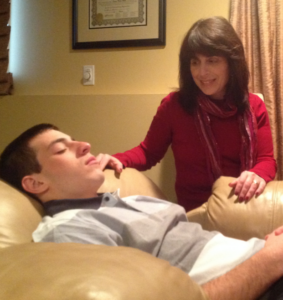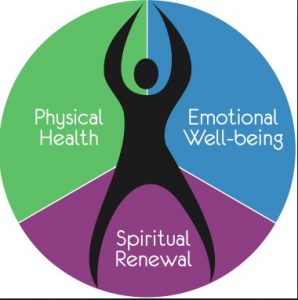
Video: Listening to hypnosis
This video explains the proper way to listen to a hypnotherapy session.

This video explains the proper way to listen to a hypnotherapy session.

 Virtual reality hypnosis (VRH) can reduce the need for postoperative opioids and anti-anxiety medications and lead to improved outcomes in children, new research suggests.
Virtual reality hypnosis (VRH) can reduce the need for postoperative opioids and anti-anxiety medications and lead to improved outcomes in children, new research suggests.
A team of anesthesiologists at the University of Texas Southwestern Medical Center and Hopitaux Universitaires de Strasbourg in France studied 21 children undergoing surgery for scoliosis, comparing 10 who received VRH in addition to the usual postoperative pain management to 11 children who did not receive VRH.
They found that the VRH group had significantly lower need for supplemental treatment for anxiety, opioid analgesics, and less incidence of vomiting as well as shorter time to urinary catheter removal and shorter time to getting up.
“Nonpharmacological approaches should play a critical role in treatment of perioperative anxiety and pain,” corresponding author Girish P. Joshi, MD, professor of anesthesiology and pain management, University of Texas Southwestern Medical Center, Dallas, told Medscape Medical News.
“This can be achieved through several approaches, including appropriate/adequate education and discussion, as well as use of novel technology,” he said. The study was presented at Anesthesiology 2018, the annual meeting of the American Society of Anesthesiologists in San Francisco.
Encouraging Findings
“Hypnosis and virtual reality (VR) have been shown to influence anxiety and chronic pain, but its role in acute pain, particularly in children, was not assessed previously,” Joshi said.
The aim of the current retrospective study was to evaluate the effects of VRH support on postoperative pain and opioids use in children undergoing scoliosis surgery.
From May 2017 onward, VRH support was added to the usual postoperative pain management in all pediatric patients, with a VRH session performed daily for 20 minutes during the first 72-hour postoperative period.
The control group consisted of children who had undergone the same procedure without VRH support before May 2017 and were demographically similar to the VRH group.
The researchers collected data regarding maximum postoperative pain scores per day, the total opioid dose, the number of postoperative vomiting episodes, request for supplemental treatment for pain and/or anxiety, time to oral intake, time to urinary catheter removal, time to getting up, and hospital length of stay.
The VRH group experienced several significant advantages over the control group:
 Total postoperative morphine consumption over the 72-hour period was almost twice as high in the control group vs the VRH group (2.15 mg/kg [1.11] vs 1.18 mg/kg [0.28] P = .015)
Total postoperative morphine consumption over the 72-hour period was almost twice as high in the control group vs the VRH group (2.15 mg/kg [1.11] vs 1.18 mg/kg [0.28] P = .015) since these are children and not adults.”
since these are children and not adults.”By: Batya Swift Yasgur, MA, LSW

 When “Comedy Hypnotist” Chris Jones invited celebrity judge Howie Mandel on stage and hypnotized him on the competition show “America’s Got Talent,” the performance brought the audience to its feet and even inspired a social media hashtag, #HowieShakesHands.
When “Comedy Hypnotist” Chris Jones invited celebrity judge Howie Mandel on stage and hypnotized him on the competition show “America’s Got Talent,” the performance brought the audience to its feet and even inspired a social media hashtag, #HowieShakesHands.
Mandel, who struggles with obsessive compulsive disorder, followed Jones’ cues and for the first time in more than eight years, the germaphobe shook hands with his fellow judges. The seemingly instant transformation was so surprising, some viewers thought it was an act, Mandel said it was not.
But according to David Spiegel, professor of psychiatry and behavioral sciences at Stanford University, not only is hypnotherapy legitimate, it’s “literally the old est Western conception of a psychotherapy.”
Moreover, Wesley Anderson, a practicing hypnotherapist for more than 20 years, said, “Most people experience some form of a hypnotic state every day.” “If you’ve ever been lost in a daydream or zoned out and missed your turn while driving your usual route, you’ve experienced a form of hypnosis,” he said.
Does it really work?
Spiegel has been conducting studies about the benefits of hypnosis for more than 40 years and he said there is no doubt that hypnosis works as an effective therapeutic technique to manage pain and kick bad habits.
In 2000, Spiegel and his colleagues determined that patients using hypnosis as a part of a comprehensive treatment plan could significantly reduce drug use and procedure time.
“Lowering those two meant an average cost savings of approximately $338,” Spiegel said.
A 2007 article in the Journal of the National Cancer Institute doubled that figure, finding that a hospital saved $772 per patient in the hypnosis group, mainly due to reduced surgical time. “Patients who received hypnosis reported less post-surgical pain, nausea, fatigue and discomfort,” according to a release from the American Psychological Association.
“Patients who received hypnosis reported less post-surgical pain, nausea, fatigue and discomfort,” according to a release from the American Psychological Association.
Hypnosis has its skeptics, partly because while studies seem to show it has tangible benefits, it’s most often used in tandem with other treatments; scientifically quantifying its success alone is difficult. From comedy performers such as Jones to Harvard educated psychiatrists such as Spiegel, anyone can learn to hypnotize and call themselves a “hypnotist,” which also gives doubters pause.
Three states — Colorado, Connecticut and Washington — require mandatory licensing requirements from individuals wanting to practice hypnotherapy.
According to the American Society of Clinical Hypnosis, or ASCH, most insurance companies will cover 50% to 80% of the cost of individual therapy, but only if treated by licensed professionals. ASCH requires its members to be licensed health care workers and, at minimum, have a master’s degree.
The National Board for Certified Clinical Hypnotherapists, on the other hand, requires applicants have a graduate-level degree as well as 50 hours of classroom instruction and 30 hours of clinical training.
How does it work?
The first thing Anderson does when meeting a new client is what anyone would do upon meeting a stranger: He gets to know them. “I try to establish a rapport and establish the client’s intentions for hypnosis,” Anderson said.
Using verbal and nonverbal cues, a hypnotherapist will help the client quiet their peripheral, conscious mind, the part that’s constantly stimulated by outside sources. Clients will relax, their posture will adjust and they will usually become very still, Anderson said. “They’re halfway between being completely asleep and completely awake,” he explained.
In this trance-like state, the part of the brain responsible for the subconscious, non-logical thoughts can become wide open to suggestions. “The normal adult filters and belief systems of what is and what isn’t will start to fade,” he said. “Clients become almost childlike.” Hypnotherapists can then begin to use imagery and suggestion to help them start thinking about their bad habits or their pain differently.
 For radio host Jenn Hobby, who underwent hypnosis to help her kick her smoking habit, that meant tapping into her relationship with her goddaughter, who at the time of her session, was just a toddler. Her hypnotherapist told her to imagine her goddaughter playing outside and running around the playground.
For radio host Jenn Hobby, who underwent hypnosis to help her kick her smoking habit, that meant tapping into her relationship with her goddaughter, who at the time of her session, was just a toddler. Her hypnotherapist told her to imagine her goddaughter playing outside and running around the playground.
“Then he said, ‘now imagine giving her a lit cigarette,'” Hobby remembers. “That really hit home, more than anything else.” When she left the office that day, she felt differently about cigarettes and smoking. Helping clients manage pain, Anderson said, he often counsels them to turn down receptors that might cause them discomfort the same way a plumber might turn off water before working to repair a leak.
“The pain signals might be there, but they wouldn’t make it into awareness,” Anderson said. Feeling ‘somewhat betrayed’ What’s vital to the process, Anderson and Spiegel said, is that both parties — hypnotherapist and client — agree to the intentions of the session beforehand. Mandel said he agreed to participate in the segment and said he knew what he was doing the entire time, but he never established a rapport with his hypnotist.
So while his “handshaking breakthrough” seemed like a positive thing, for Mandel, the former “Deal or No Deal” host said he felt “somewhat betrayed” after he watched the episode. “I was upset about it and it’s hard for me to watch,” Mandel told NBC’s Savannah Guthrie.
Spiegel said Mandel’s reaction to his experience is understandable. “When entertainers with no knowledge or concern for clinical care take advantage of a real phenomenon, real people can feel exposed, tricked or humiliated,” he said.
Only one part of the puzzle
Despite the success of Hobby’s hypnosis experience — she’s only had a few cigarettes since — she said being hypnotized wasn’t the only thing that led to her quitting. ”
There’s no magic pill. You have to be really committed to change your behavior,” she said. Spiegel agreed. Hypnosis, while valuable, is only one part of the comprehensive treatment puzzle. “Anything that can help a patient that much is worth looking into,” he said.
By: Stephanie Gallman, CNN
New research shows that hypnosedation is a valuable alternative to conventional general anesthesia. is a technique which combines hypnosis, conscious sedation (where drugs are used to make the patient comfortable and relaxed while remaining conscious), and local anesthesia to block pain.
 It has previously been shown to decrease the need for medication, reduce adverse effects, and to accelerate postoperative rehabilitation when compared to general anesthesia in which the patient is rendered unconscious.
It has previously been shown to decrease the need for medication, reduce adverse effects, and to accelerate postoperative rehabilitation when compared to general anesthesia in which the patient is rendered unconscious.
This research team led by Dr Aurore Marcou and colleagues from the Institut Curie, Paris, France, say: “By minimizing effects of anesthesia on vital functions while preserving the patients’ well-being, it contributes to a sustainable development of anesthesia.”
The authors performed a retrospective study of 150 cancer patients who were treated at the Institute Curie between 2011 and 2017, and whose operations were performed under hypnosis. Procedures were conducted with the usual safety conditions and monitoring in place, however they excluded all premedication or hypnotic drugs.
A continuous supply of the opioid remifentanil was given during each operation to keep the patients comfortable, and they were provided with the usual anti-sickness drugs and a painkiller as a preventative measure. Local or regional anesthesia was performed depending on the type and location of surgery, but the patient remained conscious throughout the procedure.
Hypnosedation was used in breast surgeries (including total mastectomies), which represented 90% of the surgeries in this study, and also gynecological surgeries, colonoscopies, and superficial plastic surgeries (representing 10% between them).
The mean duration of procedures was 60 minutes (30 to 160 minutes), and the mean length of stay in the recovery room was 35 minutes. Patients were aged from 18 to 100 years with a mean of 60.5 years, with 22% older than 75 years.
Individuals were grouped according to the severity of their condition, with 2% being classified as having severe cardiac, respiratory, or renal failures that seriously questioned the benefit of using traditional general anesthesia.
The authors found that in 99% of cases, hypnosedation provided comfortable conditions for both the patient and the surgeon operating on them. Patient discomfort happened in just two cases, and in both of these, general anesthesia was quickly and easily implemented.
The authors conclude that: “Hypnosedation can be proposed as a useful alternative to general anesthesia in various types of surgeries including major breast surgeries. By minimizing effects of anesthesia, this technique is particularly valuable for vulnerable patients. Hypnosis benefits the patient as well as the caregivers.”
News-Medical.net June 2018

 By scanning the brains of subjects while they were hypnotized, researchers at the School of Medicine were able to see the neural changes associated with hypnosis.
By scanning the brains of subjects while they were hypnotized, researchers at the School of Medicine were able to see the neural changes associated with hypnosis.
Your eyelids are getting heavy, your arms are going limp and you feel like you’re floating through space. The power of hypnosis to alter your mind and body like this is all thanks to changes in a few specific areas of the brain, researchers at the Stanford University School of Medicine have discovered.
The scientists scanned the brains of 57 people during guided hypnosis sessions similar to those that might be used clinically to treat anxiety, pain or trauma. Distinct sections of the brain have altered activity and connectivity while someone is hypnotized, they report in a study published online July 28 in Cerebral Cortex.
“Now that we know which brain regions are involved, we may be able to use this knowledge to alter someone’s capacity to be hypnotized or the effectiveness of hypnosis for problems like pain control,” said the study’s senior author, David Spiegel, MD, professor and associate chair of psychiatry and behavioral sciences.
A serious science
For some people, hypnosis is associated with loss of control or stage tricks. But doctors like Spiegel know it to be a serious science, revealing the brain’s ability to heal medical and psychiatric conditions.
“Hypnosis is the oldest Western form of psychotherapy, but it’s been tarred with the brush of dangling watches and purple capes,” said Spiegel, who holds the Jack, Samuel and Lulu Wilson Professorship in Medicine. “In fact, it’s a very powerful means of changing the way we use our minds to control perception and our bodies.”
Despite a growing appreciation of the clinical potential of hypnosis, though, little is known about how it works at a physiological level. While researchers have previously scanned the brains of people undergoing hypnosis, those studies have been designed to pinpoint the effects of hypnosis on pain, vision and other forms of perception, and not the state of hypnosis itself.
“There had not been any studies in which the goal was to simply ask what’s going on in the brain when you’re hypnotized,” said Spiegel.
 Finding the most susceptible
Finding the most susceptible
To study hypnosis itself, researchers first had to find people who could or couldn’t be hypnotized. Only about 10 percent of the population is generally categorized as “highly hypnotizable,” while others are less able to enter the trancelike state of hypnosis.
Spiegel and his colleagues screened 545 healthy participants and found 36 people who consistently scored high on tests of hypnotizability, as well as 21 control subjects who scored on the extreme low end of the scales.
Then, they observed the brains of those 57 participants using functional magnetic resonance imaging, which measures brain activity by detecting changes in blood flow. Each person was scanned under four different conditions — while resting, while recalling a memory and during two different hypnosis sessions.
“It was important to have the people who aren’t able to be hypnotized as controls,” said Spiegel. “Otherwise, you might see things happening in the brains of those being hypnotized but you wouldn’t be sure whether it was associated with hypnosis or not.”
Brain activity and connectivity
Spiegel and his colleagues discovered three hallmarks of the brain under hypnosis. Each change was seen only in the highly hypnotizable group and only while they were undergoing hypnosis.
First, they saw a decrease in activity in an area called the dorsal anterior cingulate, part of the brain’s salience network. “In hypnosis, you’re so absorbed that you’re not worrying about anything else,” Spiegel explained.
 Secondly, they saw an increase in connections between two other areas of the brain — the dorsolateral prefrontal cortex and the insula. He described this as a brain-body connection that helps the brain process and control what’s going on in the body.
Secondly, they saw an increase in connections between two other areas of the brain — the dorsolateral prefrontal cortex and the insula. He described this as a brain-body connection that helps the brain process and control what’s going on in the body.
Finally, Spiegel’s team also observed reduced connections between the dorsolateral prefrontal cortex and the default mode network, which includes the medial prefrontal and the posterior cingulate cortex.
This decrease in functional connectivity likely represents a disconnect between someone’s actions and their awareness of their actions, Spiegel said. “When you’re really engaged in something, you don’t really think about doing it — you just do it,” he said.
During hypnosis, this kind of disassociation between action and reflection allows the person to engage in activities either suggested by a clinician or self-suggested without devoting mental resources to being self-conscious about the activity.
Treating pain and anxiety without pills
In patients who can be easily hypnotized, hypnosis sessions have been shown to be effective in lessening chronic pain, the pain of childbirth and other medical procedures; treating smoking addiction and post-traumatic stress disorder; and easing anxiety or phobias. The new findings about how hypnosis affects the brain might pave the way toward developing treatments for the rest of the population — those who aren’t naturally as susceptible to hypnosis.
“We’re certainly interested in the idea that you can change people’s ability to be hypnotized by stimulating specific areas of the brain,” said Spiegel.
A treatment that combines brain stimulation with hypnosis could improve the known analgesic effects of hypnosis and potentially replace addictive and side-effect-laden painkillers and anti-anxiety drugs, he said. More research, however, is needed before such a therapy could be implemented.
The study’s lead author is Heidi Jiang, a former research assistant at Stanford who is currently a graduate student in neuroscience at Northwestern University.
Other Stanford co-authors are clinical assistant professor of psychiatry and behavioral sciences Matthew White, MD; and associate professor of neurology Michael Greicius, MD, MPH.
The study was funded by the National Center for Complementary and Integrative Health (grant RCIAT0005733), the National Institute of Biomedical Imaging and Bioengineering (grant P41EB015891), the Randolph H. Chase, M.D. Fund II, the Jay and Rose Phillips Family Foundation and the Nissan Research Center.
Stanford’s Department of Psychiatry and Behavioral Sciences and Department of Neurology and Neurological Sciences also supported the work.
By; Sarah P. Williams